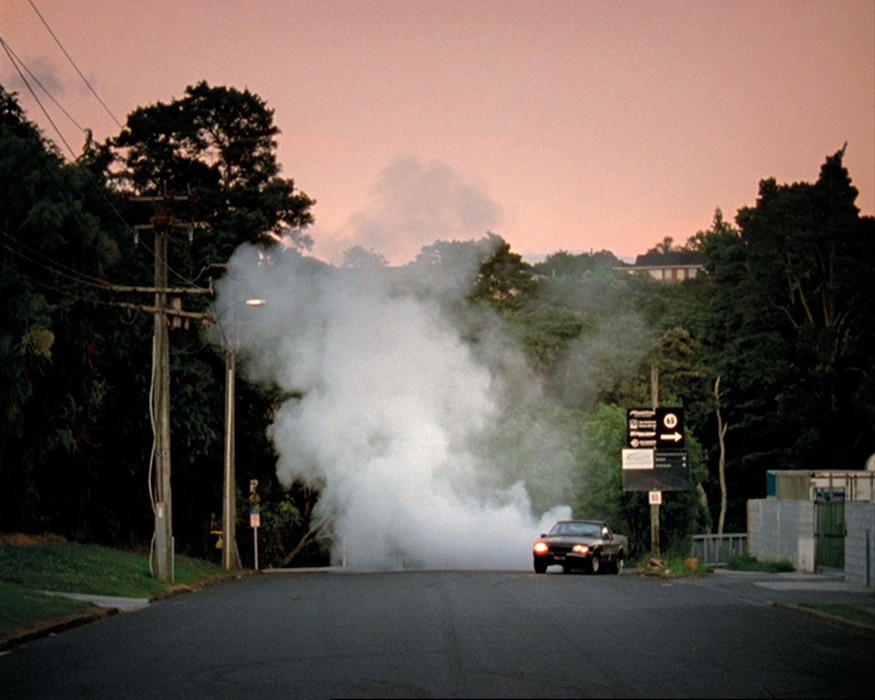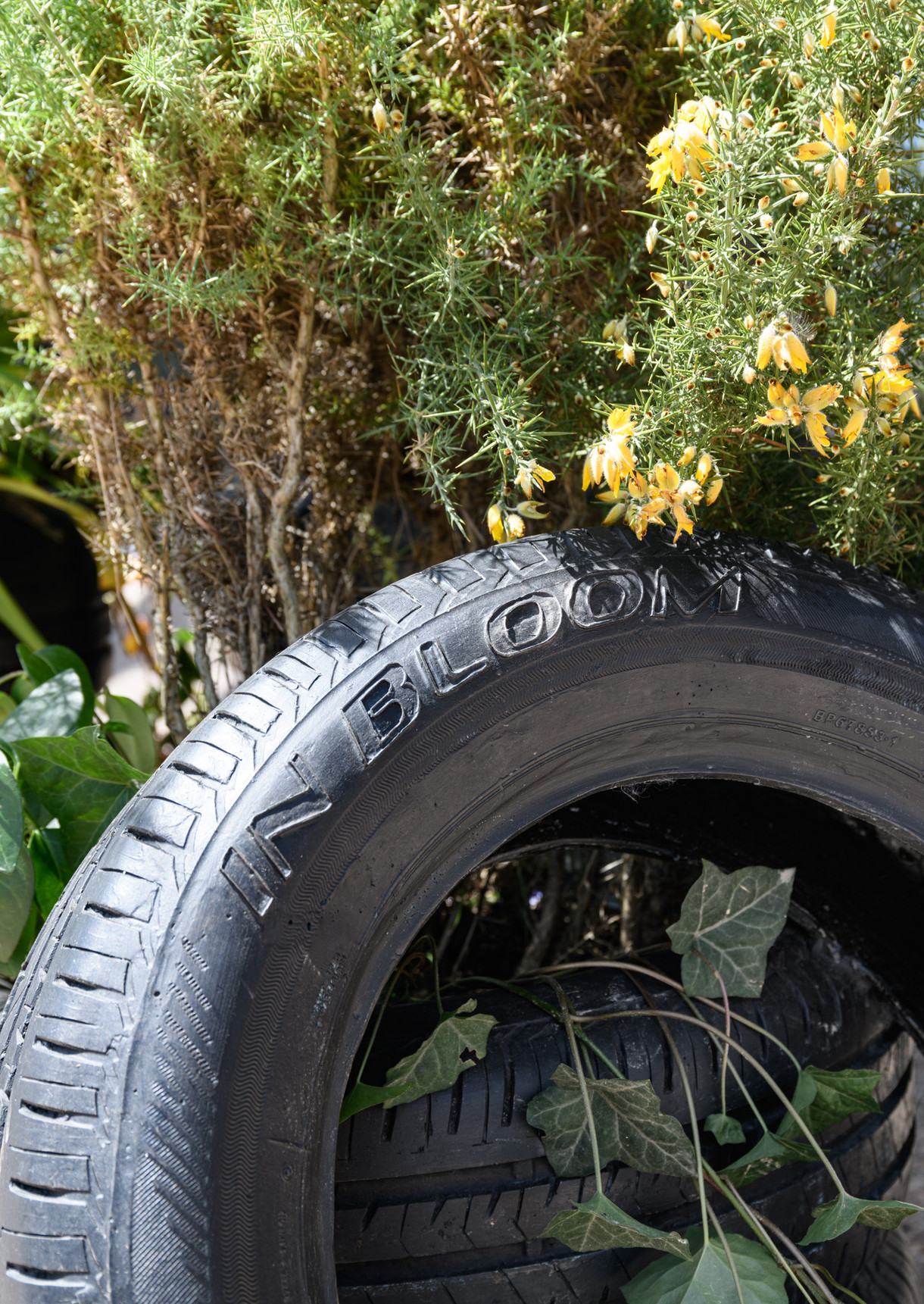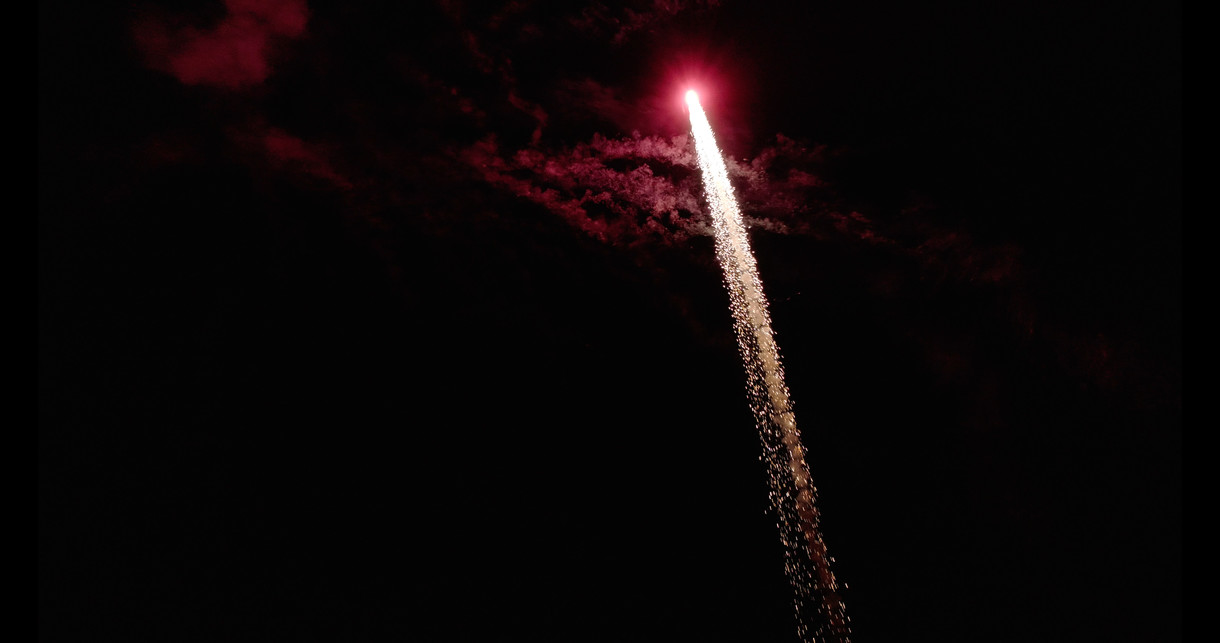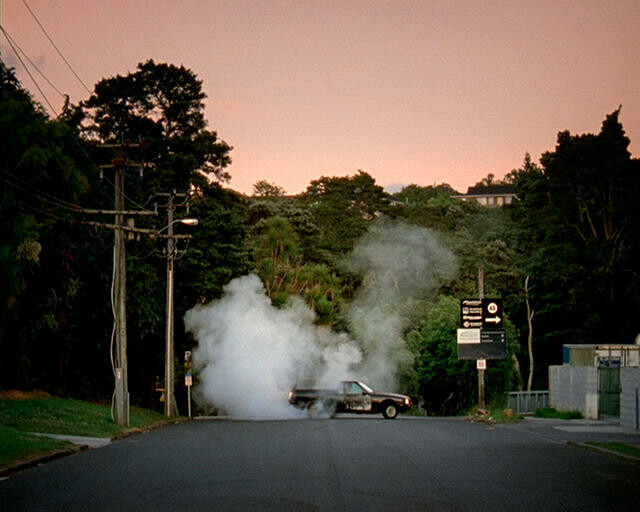Steve Carr: Transpiration

Steve Carr Transpiration 2014. 6-channel installtion, Sony XD, duration 15 mins (looped). Courtesy the artist and Michael Lett
In Steve Carr's Transpiration (2014), huge carnations hover in half-dozen clusters on the wall. They start their lives looking like balls of cotton rags – white, bunchy, frayed. Colour then gathers at their fringes and grows into a slow leach that turns them yellow, or pink, or blue. The flowers’ inner folds wobble slightly. There’s a more general sway at their outer limits – a kind of peripheral rocking. Single petals peel away, minuscule movements that turn into sublime shocks when you manage to catch one at the edges of your vision.
For all that, there’s still the sense that maybe nothing is happening. While I’m there, a young woman walks into the flower-filled room and is convinced she’s seeing a frozen image. When she sees a petal move, she wonders aloud whether the flowers are changing colour before her eyes. She pauses, before announcing that it’s all a ruse.
There’s nothing special about Carr’s flowers, which are just shop-bought blooms. The process being witnessed is pretty basic too: the carnations are sitting in unseen pots of coloured water, sucking it up through their stems.
It’s a primary school magic trick, a way to teach kids about natural science as well as a cheap device florists use to stain their stock. Carr has shot the process over twenty-four hours with a time-lapse camera, then stitched it together into a loop of around fifteen minutes, which runs forwards and back so that we witness the flowers’ inhalation and exhalation as a constant, tidal pulse.
The banality of the work’s origins is transformed by the weight of art history. Although the flowers aren’t painted, they’re thick with paint. Their ragged edges are like the final drags of a brush before it breaks from the surface. The white on black is as stark and luminescent as Manet (one of the greatest flower painters), or Chardin, or even Velázquez. Carr’s carnations are also a clear nod to Andy Warhol’s Flowers and to Jean Cocteau’s film Testament of Orpheus, where flowers become essential, surrealist symbols at the end of the film. From Cocteau to Warhol to Carr; a lineage that reaches through classroom science experiments and impressionism, all the way back to seventeenth-century still-lifes. Except that Carr’s flowers are never still.
We’re used to thinking about cinema as a photographic medium. But conceptually and behaviourally, it shares a great deal with painting, in that both are concerned with the relationships between images and the passing of time. In painting, this is subtle and easy to miss because at first glance, its objects are static things: stillnesses, hanging on walls. Nothing moves. And yet a painting’s surface is also an indexical record of the time it took to be made, every mark and stroke the trace of a body moving through space.
Cinema has a similar ability to defeat the laws of time and space. It can collapse whole lives into minutes, carry us across the world in the flash between frames, and slow time down to fix our attention on the quiet, unseen forces underpinning daily experience.
As well as being filmmakers, Warhol and Cocteau were painters. Many of cinema’s greatest directors are, or were. David Lynch is another. Perhaps that’s why he is also present in Carr’s installation. The experience of watching Transpiration at the DPAG was punctuated every fifteen minutes by the bright chirps of a mechanical bird, coming from a television screen in one corner. On the screen was a companion work, American Night (2014). In it, a little bird perches on a fake branch, against a background of spring blossom. It’s an obvious set-up, and an incongruous letdown after the magic of Carr’s giant floral illusion. But the two works are actually showing the same thing. As the screen’s artificial day disappears into false night, it becomes clear that, here too, we’re witnessing a twenty-four-hour cycle shrunk to a handful of minutes. As the sun comes up, the bird lets off its frenetic tweet. Just like Transpiration, Carr is riffing here on one of the great final scenes of modern film; instead of Testament of Orpheus, this time it is Blue Velvet, when a fake bird closes out Lynch’s dreamscape.

Steve Carr American Night 2014. Single channel film, Blackmagic 4K, duration 15 mins (looped). Courtesy the artist and Michael Lett
In the time it takes us to watch the bird’s daily cycle, everything is new, different and somewhere else: the flowers’ blues are white and whites are pink and some yellows have turned so bright they’re almost phosphorescent green. It’s the strongest evidence yet of Carr’s ever-increasing ability to control, and reinvent, the interaction between painting’s history, film’s materiality and cinematic time.
It’s also a reminder that Carr’s videos are about screens, in the same way that paintings are about screens: material things that act as images, as windows and as defeaters of sensible time. Like great painting, Transpiration is about what happens to our experience of the space around the work – just like the young woman who swore she’d seen a mirage.
The first time the art world really noticed Carr was in 2001, when he presented the video Air Guitar as part of his final student exhibition at Elam School of Fine Arts. In it, Carr acts out a stadium-rock fantasy, miming a classic track from Joe Satriani’s album Surfing with the Alien. Things develop as one would expect in any teenage boy’s bedroom, until Carr dials the hubris up to ten. As a smoke machine shrouds him in a starstruck fog, he grows in confidence and strut, letting off a couple of Pete Townshend-style windmills before returning to his phantom solo.
As funny as it is, Carr’s silent performance homes us in on a second layer of teenage male fantasy – all the bucking, thrusting and straining make it clear that this is, more than anything else, a wank video. Watching Carr pound away at his absent axe becomes ridiculous and awkward; he turns us into his mum, walking in at the worst possible moment.
This wilfully untoward sexuality didn’t pass in a hurry. In 2002, he made Pillow Fight, in which he and a group of teenage girls have a pyjama party and smash each other around, sending clouds of feathers into the air. Not long after this came Dive Pool: a film shot underwater of Carr in a scuba mask, watching bikini-clad women swim past him while he sucks in oxygen – evenly, mechanically – from the tank on his back.
Ostensibly, there was nothing wrong with these acts, except of course, that everything was wrong with them. Carr used plausible deniability to infect childish activities with an implicit sexuality. For some critics, this tipped past the early humour of Air Guitar and into a more corrupt space. Rather than backing down, Carr made one of his funniest films in response: Tiger Girls (2004), in which he sits in a spa pool filled with attractive young women and does absolutely nothing except drain several bottles of Tiger Beer.
There’s no question that Carr’s early games, performances and gags were adolescent, narcissistic and self-obsessed. But they were also important steps in his attempt to master a more archetypal condition: Carr is, above all else, a trickster.
In his book Trickster Makes This World, Lewis Hyde shows us that the trickster is, in every culture in which it appears, a force for change. Central to this is the power to step across the thresholds between gods and men and life and death, unencumbered or deliberately negligent of the rules that dictate behaviour in each. The trickster is also responsible for the forces that keep us rooted in our own mortality; most notably, our desires – our need to eat, to drink, to fight, to love, to fuck and so on. The trickster’s troublemaking reminds us that we’re only flesh and bone, and that our bodies are both contingent on, and vulnerable to, our appetites. Little wonder, then, that Carr’s early works were full of booze and sex.

Steve Carr Burn Out 2009. 16mm film transferred to digital video (4min 53 sec). Collection of Christchurch Art Gallery Te Puna o Waiwhetū, gift of the Friends of Christchurch Art Gallery 2016
By 2009, Carr himself had largely disappeared from his films. Instead he began to focus on the close interconnectedness of his core mercurial forces – sex, mischief, humour and magical transformation. This came to a head in one of his finest and most painterly works, his 16-millimetre film Burn Out (2009). On an early West Auckland morning, a young man in a black car does exactly what the title suggests. But rather than the jump-cuts and heavy-metal typical of YouTube videos of burnouts, Carr’s event is shot at distance against lush Henderson bush, with no sound. There’s a rough, transformative physicality to the action: rubber turning into smoke for no good reason other than for its beautiful grandeur. It is, in many ways, Air Guitar redux: smoke, circles, humour, solitary romance, hopeless bogan endeavour. Except what we’re witnessing this time isn’t a fantasy or a jack-off but a tangible transformation (rubber combusting into smoke).
This is a vital shift: because with Burn Out and everything since, Carr, instead of using himself, now uses matter undergoing extreme change to lead us across thresholds.
Nowhere is this clearer than in Screen Shots (2011). Across nine monitors arranged in a three-by-three grid, we see the artist’s hand slowly pricking paint-filled balloons against a coloured background. As the pin slips in and each balloon peels back, there’s a brief and wondrous moment in which the paint holds its shape and wobbles in mid-air before coming apart. Once again, Carr transforms a childish pleasure (blowing up a paint bomb) into something erotic and sublime.
The explosions are filmed using a Phantom camera, capable of shooting high-definition footage at more than 5,400 frames per second. It’s designed to show us things our eyes weren’t meant to see. Carr doesn’t use the Phantom to get off on its technological capabilities, but rather to create an image of total bodily empathy. His balloons, and the paint they contain, hang like organs and burst with human release. To over-emphasise this, they’re presented on 32-inch screens, which provide a 1:1 scale between the artist/magician’s hand and our own. Carr can’t resist a dig at painting’s history here either, crashing the absurdity of abstract expressionism’s drippy masculinity into its fussy, industrial cousin – the pristine minimalist grid.
In Dead Time (2012), Carr used the Phantom to mine even deeper into art history. Seven screens hang, like still-life paintings, in a row. On each, a single apple is suspended from a string against a black ground. The inspiration for his composition is obvious and unhidden: the paintings of the Spanish master Juan Sánchez Cotán. Each apple is just different enough for us to realise that it isn’t the same image repeated seven times. Then we’re forced to wait, and wait. But for those patient enough, the payoff arrives – a William Tell succession of explosions as each apple is obliterated, one after the other, by a single bullet that traces visibly across the screens. By stretching an event that lasts a few seconds to several minutes, Carr allows us to witness not just action, but complete, painterly disintegration. The last flecks of apple flesh look like stars spread across black space – a Big Bang that tricks us into thinking, just for a moment, that we’re staring into the heart of the universe.
Transpiration, then, is more than a one-off victory over time and space; it’s the culmination of an intense period of magical experimentation. Carr’s carnations are the sorts of things a clown might use to squirt you in the eye. But they’re also paintings, bodies, organs demanding slow release and things experiencing their own death, over and again.
The great sophistication of Carr’s recent works lies in his recognition that the forces of material transformation he’s so interested in – combustion, explosion, degradation, disintegration, transpiration – are, like cinema and painting, entirely contingent on time, and that the tools of his trade give him the ability not only to witness temporal change, but completely alter our experience of it. In doing this, Carr allows us to breathe underwater, see the universe in a shattered apple and disappear with him into clouds of smoke.
A version of this essay was first published in Art New Zealand in 2014, and later adapted for his book This Model World: Travels to the Edge of Contemporary Art (AUP 2016).










